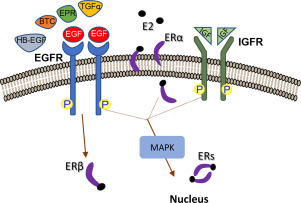Cellular Signalling ( IF 4.8 ) Pub Date : 2018-07-31 , DOI: 10.1016/j.cellsig.2018.07.010 Konstantina Kyriakopoulou , Elena Kefali , Zoi Piperigkou , Heba Bassiony , Nikos K. Karamanos

|
Breast cancer is the most common malignancy among women worldwide. The role of epidermal growth factor receptor (EGFR) in many epithelial malignancies has been established, since it is dysregulated, overexpressed or mutated. Its overexpression has been associated with increased aggressiveness and metastatic potential in breast cancer. The well-established interplay between EGFR signaling pathway and estrogen receptors (ERs) as well as major extracellular matrix (ECM) mediators is crucial for regulating basic functional properties of breast cancer cells, including migration, proliferation, adhesion and invasion. EGFR activation leads to endocytosis of the receptor with implications in the regulation of downstream signaling effectors, the modulation of autophagy and cell survival. Therefore, EGFR is considered as a promising therapeutic target in breast cancer. Several anti-EGFR therapies (i.e. monoclonal antibodies and tyrosine kinase inhibitors) have been evaluated both in vitro and in vivo, making their way to clinical trials. However, the response rates of anti-EGFR therapies in the clinical trials is low mainly due to chemoresistance. Novel drug design, phytochemicals and microRNAs (miRNAs) are assessed as new therapeutic approaches against EGFR. The main goal of this review is to highlight the importance of targeting EGFR signaling pathway in terms of its crosstalk with ERs, the involvement of ECM effectors and epigenetics. Moreover, recent insights into the design of specialized delivery systems contributing in the development of novel diagnostic and therapeutic approaches in breast cancer are addressed.
中文翻译:

靶向表皮生长因子受体信号转导通路在乳腺癌中的研究进展
乳腺癌是全世界女性中最常见的恶性肿瘤。表皮生长因子受体(EGFR)在许多上皮恶性肿瘤中的作用已经确立,因为它失调,过度表达或突变。它的过表达与乳腺癌的侵略性和转移潜力增加有关。EGFR信号通路与雌激素受体(ER)以及主要细胞外基质(ECM)介体之间的良好相互作用对调节乳腺癌细胞的基本功能特性(包括迁移,增殖,粘附和侵袭)至关重要。EGFR激活导致受体的内吞作用,涉及下游信号传导效应子的调节,自噬的调节和细胞存活。所以,EGFR被认为是乳腺癌中有希望的治疗靶标。几种抗EGFR疗法(即单克隆抗体和酪氨酸激酶抑制剂)二者已被评估在体外和在体内,使他们的方式来进行临床试验。然而,在临床试验中抗EGFR疗法的反应率很低,这主要归因于化学抗性。新型药物设计,植物化学物质和microRNA(miRNA)被评估为针对EGFR的新治疗方法。这篇综述的主要目的是从与ER的串扰,ECM效应子的参与和表观遗传学的角度,强调靶向EGFR信号通路的重要性。此外,解决了对专门的递送系统设计的最新见解,该系统有助于乳腺癌新的诊断和治疗方法的发展。



























 京公网安备 11010802027423号
京公网安备 11010802027423号